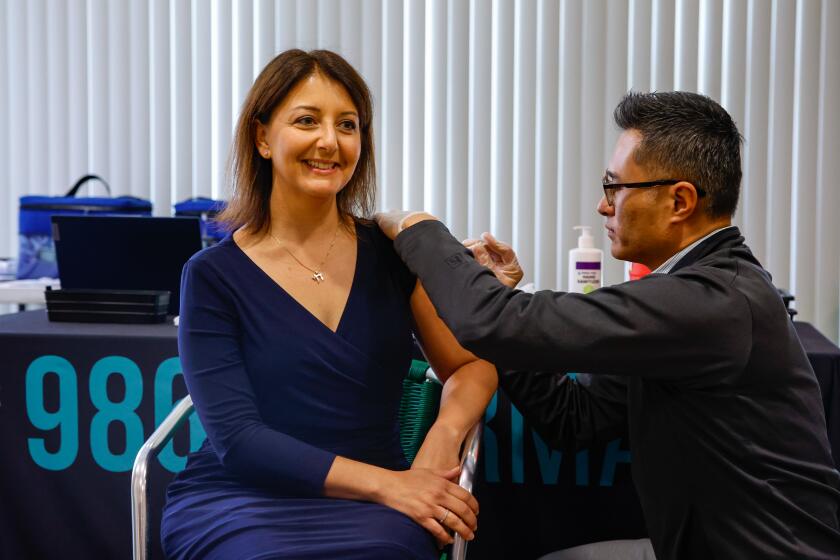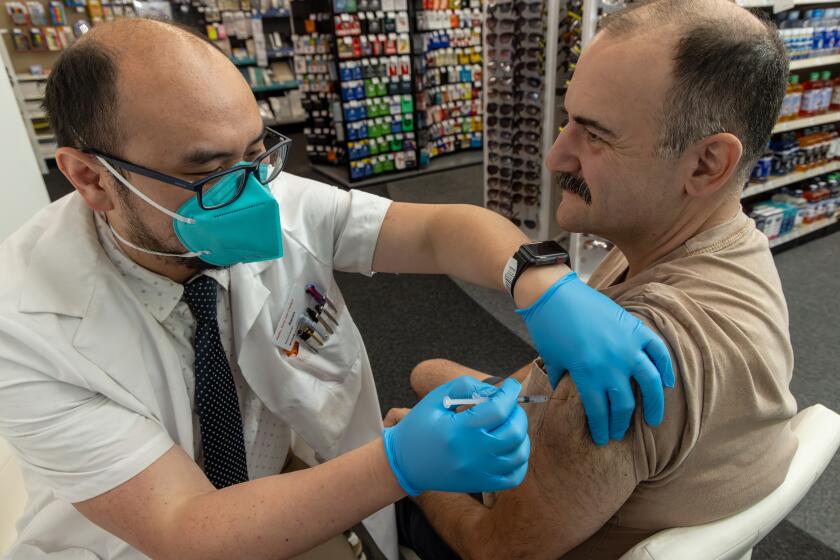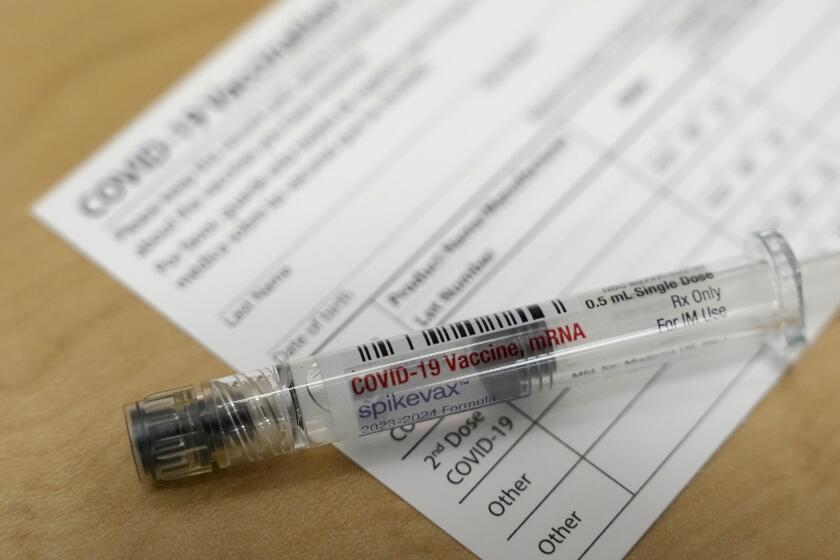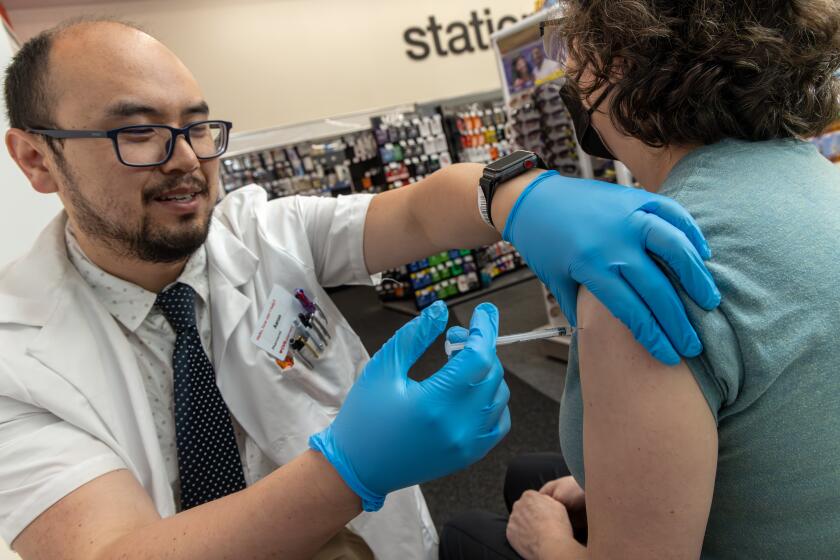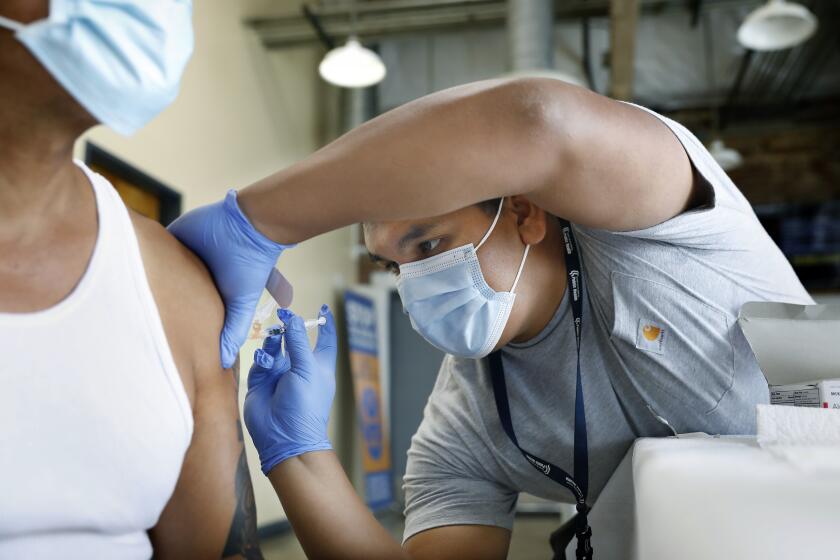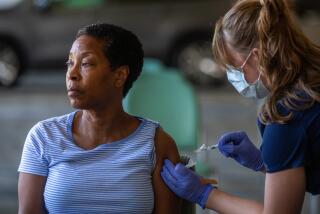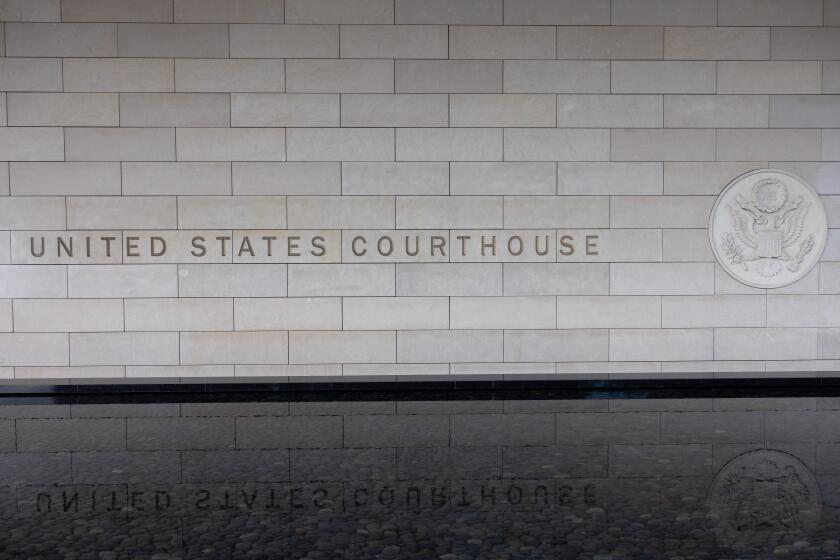New COVID vaccines are here: Now’s the time to get one, officials say

- Share via
With Halloween just days away, and the wider autumn and winter holiday season fast approaching, now is the time for most everyone to get their updated COVID-19 vaccine, officials say — especially since initial supply shortages have eased.
There are some indications the winter respiratory virus season is just beginning, exacerbating the threat not only of another potential coronavirus wave, but a resurgence of flu and respiratory syncytial virus, or RSV. Last year, all three viruses surged roughly simultaneously, leaving hospitals straining under the weight of a so-called tripledemic.
“We have a good supply of COVID-19 and flu vaccines in Los Angeles County and there are options for everyone 6 months and older,” county Public Health Director Barbara Ferrer said in a statement. “I hope that if many people take advantage of the updated vaccines, L.A. County can avoid a big surge in respiratory virus cases this winter that strains our healthcare system and leads to more deaths.”
So far, though, uptake of the updated shots has not been up to snuff for public health officials.
Only 5% of Californians, or 1.8 million people, have received the updated COVID-19 vaccine since it became available last month. Among seniors, the rate is 14%.
“That’s not good enough. We should really be seeing much higher rates, especially amongst the old,” Dr. Tomás Aragón, director of the California Department of Public Health, said at a briefing Thursday. “Winter is coming.”
The Centers for Disease Control and Prevention says October is the right time to get vaccinated, before COVID circulation really ramps up.
Getting the updated shot now, health officials say, will help protect people against the expected wave of COVID-19 that’s historically arrived in November and December.
Federal survey data suggest that 7% of U.S. adults got the new COVID-19 vaccine in the first month of the rollout. In a survey in August, 43% of U.S. adults said they planned to get the latest COVID-19 vaccine, according to findings shared by the U.S. Centers for Disease Control and Prevention.
Such uptake would be more in line with that of the annual flu shot. Survey results suggest 47% of U.S. adults got vaccinated during the 2022–23 flu season. By contrast, only 21% of adults nationwide received the previously updated COVID-19 shot after it was introduced a year ago.
Separately, a survey of more than 1,000 L.A. County adults by the USC Pandemic Research Center suggested that 64% planned on getting the updated COVID-19 vaccine. That would be significantly higher than the 20% of county residents 5 and older and 41% of seniors countywide who received last year’s reformulated COVID-19 vaccine.
While state officials are pushing for more residents to get vaccinated, the L.A. City Council on Wednesday introduced a motion to sunset that requirement for city employees. If enacted, it would align with similar outside policies, including in L.A. County and the federal government. The state of California ended coronavirus test requirements for unvaccinated state employees in 2022.
The updated COVID-19 vaccine is now available at all eight of L.A. County’s public health centers as well as clinics near Watts and East L.A.
There remain demographic disparities among those who are getting vaccinated. Nearly 9% of those living in California’s wealthiest communities have received the new COVID vaccine, compared with fewer than 2% of those living in the lowest-income areas.
Roughly 7% of white Californians have gotten the vaccine, as have 6% of Asian Americans, 4% of Native Hawaiian/Pacific Islanders, 3% of Black, Native American and multiracial Californians and 1.5% of Latino residents.
“If you’re 6 months or older, you should be getting vaccinated” against COVID-19, regardless of previous immunizations, Aragón said. “It’s no longer a booster. This is now just one shot. And if it’s been at least two months since the last time you may have received the old bivalent ... booster, or at least three months since you’ve recovered from an infection, all you need is one shot.”
There are a couple of exceptions. The youngest children and those who are immunocompromised may need more than one dose. That is also the case for previously unvaccinated people choosing to get the Novavax vaccine for their first COVID inoculation.
U.S. health officials are urging almost everyone to get both an updated COVID-19 shot and flu vaccine. An RSV shot is advised for older adults and women in late pregnancy as well.
Vaccine supply shortages have eased in recent weeks. But Kaiser Permanente members in Southern California in particular have reported major problems, including being unable for weeks to find appointments close to their homes.
In a statement Thursday, Kaiser said it has a stable supply of the Pfizer-BioNTech vaccine for all age groups.
“All healthcare providers nationwide have experienced supply and shipment challenges during the initial launch of the updated COVID-19 vaccine. The majority of those issues have been resolved,” the statement said.
Kaiser said some of its locations do not require appointments and that “appointments are being added as needed.”
The L.A. County Department of Public Health has said anyone — including Kaiser members — can get the COVID-19 vaccine at no cost at their vaccine sites, including Ted Watkins Memorial Park in Florence-Firestone and Eugene A. Obregon Park in East L.A., which are open from 11 a.m. to 6 p.m. Wednesday through Sunday.
The county also offers vaccinations at eight public health centers in downtown L.A., Hollywood, Willowbrook, Monrovia, Pacoima, Pomona, Whittier and Lancaster.
The county Department of Public Health is considered in-network for all insurers, and can bill Kaiser for the vaccinations.
The new COVID shot is available at CVS and Walgreens at no cost through most insurers. But Kaiser enrollees must wait until Sept. 28 to avoid paying out of pocket.
Uninsured children can get COVID vaccines for free through the Vaccines for Children program. Uninsured adults can get access to free vaccines through Bridge Access Program sites, which include federally qualified health centers and CVS and Walgreens.
No-cost COVID-19 vaccines are also available at the Orange County Health Care Agency’sFamily Health Clinic in Santa Ana.
For now, coronavirus levels in wastewater continue to trend downward in Los Angeles County. For the week that ended Oct. 14, the most recent available, the coronavirus level in sewage was 12% of last winter’s peak, down from 14% the previous week.
This late-year respiratory virus season is the first since the official end of the COVID-19 emergency. And as many return to pre-pandemic norms such as large indoor family gatherings, Aragón urged residents to get vaccinated not only against COVID-19, but the flu and, for those who are recommended, RSV.
As with COVID, officials recommend everyone 6 months and older get vaccinated against the flu — via either a shot or a nasal spray. October is an ideal time to get the flu vaccine, but getting it later in the season can still be helpful. Older people also are eligible for a high-potency version of the flu vaccine.
One new development for the flu vaccine this year is that people with a history of allergy to eggs no longer need to take additional safety precautions, according to the CDC.
Most flu vaccines contain a small amount of egg proteins, such as ovalbumin. “However, studies that have examined the use of both the nasal spray vaccine and flu shots in egg-allergic and non-egg-allergic patients indicate that severe allergic reactions in people with egg allergies are unlikely,” the CDC said.
People who have allergies to other ingredients in the flu vaccine should still avoid getting vaccinated, the CDC said.
In order to move through a world where the coronavirus is endemic, we need a reliable way to assess our individual level of immunity. Here’s how we can.
Though flu and COVID-19 are not yet spreading widely, circulation of RSV is starting to pick up, Aragón said. RSV can be dangerous, especially for infants and older adults. Immunizations are available — at least for certain people.
Those who are at least 60 should talk with their doctor about getting an RSV vaccine, officials say. There are two brands of RSV vaccines available for this age group, one made by GSK, known as Arexvy;and Abrysvo, made by Pfizer.
“Those that have chronic medical conditions are the ones that are at highest risk,” Aragón said. However, “if you’re otherwise a very, very healthy 60-year-old, 65-year-old, in consultation with your doctor, you may decide that you’re not going to get the vaccine” for RSV.
Those who are pregnant can also get a RSV vaccine. They should get it during September through January, only when they are weeks 32 and 36 of their term, to reduce the risk of severe disease in their infants, as the baby will receive protection that will last for months after birth.
Another option to protect newborns is to give them, after birth, an immunization that has preventive antibodies that helps fight RSV infections and protects them from getting very sick.
The immunization is suggested for infants 8 months and younger, as well as those age 8 to 19 months who are at higher risk of severe illness. These antibodies — known by the generic name nirsevimab and the trademarked name Beyfortus, which was developed by AstraZeneca and Sanofi — are recommended between September and January to help protect babies during RSV season.
There is a shortage of the nirsevimab immunization, the CDC said this week, particularly for prefilled syringe doses intended for babies weighing 11 or more pounds. The CDC recommended that for babies in that weight range, only those at highest risk for severe RSV disease get the immunization.
Los Angeles County officials said they have no plans for new public mask mandates — a sign of how COVID-19 policies have changed in the back-to-normal era.
Masking up continues to be an important tool to help prevent the transmission of infectious diseases, Aragón added, as well as “opening the windows, choosing to eat outdoors, being in spaces that are well ventilated, making sure that you wash your hands, and of course, staying home when you’re sick, and making sure that you get tested.”
Free coronavirus tests remain available at libraries run by the city and the county of Los Angeles, vaccination sites run by the county Department of Public Health, and many food banks and senior centers. Households are also eligible to order four free at-home tests through covid.gov/tests.
In California, most private insurance plans regulated by the state must reimburse their members for eight at-home COVID test kits a month through Nov. 11. After that date, free COVID tests must still be provided through most insurance plans, but covered people must go through an in-network provider to get them at no cost.
For a number of Medicare patients in California, free COVID-19 at-home tests ended on May 11, but COVID-19 testing remains free if ordered by a doctor. For people with a Medicare Advantage plan, the cost of at-home test kits varies and might remain free in some plans, according to the California Department of Public Health.
The L.A. County Department of Public Health suggested that people test for the coronavirus ahead of indoor Halloween and other holiday activities if the guest list includes people at higher risk, such as grandparents, infants and those who are pregnant.
People who get COVID-19 or flu should ask their healthcare provider about treatment options, such as Paxlovid for COVID or a number of anti-flu drugs.
More to Read
Sign up for Essential California
The most important California stories and recommendations in your inbox every morning.
You may occasionally receive promotional content from the Los Angeles Times.
